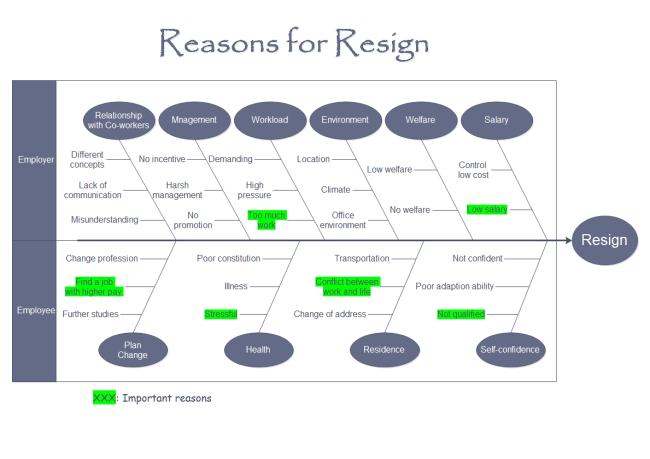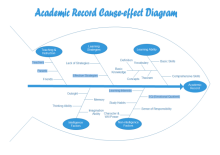Cause and Effect Diagram: Reasons for Resign
Importance of Analyzing Resign Reasons
Every day many employees resign for a multitude of reasons. As for the employer, it is crucial to reduce employee turnover to gain a team with high motivation and morale. High employee turnover will result in increased costs of workforce and a low motivation and morale due to the constantly flow of new team members. And frequent change of team member will require more time of training and getting along with each other.
Here is a good way to decrease staff resign as much as possible: cause and effect analysis. That is to say, by finding out the possible causes and then figure out the top reasons, employers can make some changes or improvement to retain and attract more talents. A template is presented below.

The highlighted ones are the top reasons, including the followings:
Reasons of Resign
1. Salary Expectations. After a few years at work, employees' salary usually increases but sometimes the increase may be not as substantial as they had hoped. Another pay related reason for leaving a job may be that the organization they are working for is paying relatively low salary in the industry. After the employees find out the fact or get a higher paid job, they often decide to leave.
2. Workload Stress. Long work hours and large workload will exert constant pressure to workers. Stress is a major cause for resigns. Stressed employees perform less productively and their work often affects their personal life to the point where they have no choice but to quit. Even with high salaries and a multitude of benefits, employees usually emphasize their health and life quality more than money and will not hesitate to leave.
3. Self-confidence. It is also common that the employees have to leave for incompetence. He may lack self-confidence for big challenge. Sometimes, he may feel hard to adapt to the new environment in a strange place with the co-workers from different regions.
From the diagram, readers can see at a glance what to do to maintain low employee turnover. Among the listed factors, the employers can at least improve office environment, establish some incentive systems and enhance the leadership to create a better working atmosphere. And it is also not difficult to maintain harmonious staff relationship by holding some activities and communicate more with staff.
In a word, there are various reasons why an employee may quit. For the employee, it is important to resign with dignity and, for the employer, it is important to accept resignations with grace.
How to Create Cause and Effect Diagram
Of course, this diagram hasn't listed all possible reasons yet and different organizations are different concerned about this issue. When creating your own diagram about this topic, you can click the picture to download it and then easily delete or add new categories of reason. All the shapes and lines of the diagram are designed with connection points. See how to create fishbone diagram quickly in Make a Fishbone Diagram and how to gain customizable results in Customizing Your Fishbone Diagram.
From the above cause and effect diagram, we can see that the major factors causing resign can be divided into employer perspective and employee perspective. This can be illustrated by a swimlane shape (or cross-functional shape).
Cause and Effect Diagram Examples
The title of this template is highlighted by Vector text, which can be adjusted just like other Edraw shapes. A fish frame shape is used to surround all causes, making the diagram more vivid.



